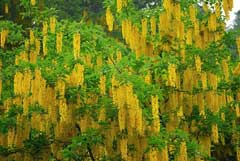 |
|
http://commons.wikimedia.org/wiki/User:Etienne |
 |
| http://commons.wikimedia.org/wiki/User:Etienne |
Translate this page:
Summary
Bloom Color: Yellow. Main Bloom Time: Early spring, Late spring, Mid spring. Form: Upright or erect.
Physical Characteristics

 Laburnum alpinum is a deciduous Tree growing to 5 m (16ft) by 6 m (19ft) at a fast rate.
Laburnum alpinum is a deciduous Tree growing to 5 m (16ft) by 6 m (19ft) at a fast rate.
See above for USDA hardiness. It is hardy to UK zone 5. It is in flower from May to June, and the seeds ripen from September to October. The species is hermaphrodite (has both male and female organs) and is pollinated by Insects.
It can fix Nitrogen.
Suitable for: light (sandy), medium (loamy) and heavy (clay) soils, prefers well-drained soil and can grow in heavy clay and nutritionally poor soils. Suitable pH: mildly acid, neutral and basic (mildly alkaline) soils. It can grow in semi-shade (light woodland) or no shade. It prefers dry or moist soil. The plant can tolerates strong winds but not maritime exposure.
It can tolerate atmospheric pollution.
UK Hardiness Map
US Hardiness Map
Synonyms
Cytisus alpinus.
Plant Habitats
Woodland Garden Dappled Shade; Shady Edge;
Edible Uses
References More on Edible Uses
Medicinal Uses
Plants For A Future can not take any responsibility for any adverse effects from the use of plants. Always seek advice from a professional before using a plant medicinally.
Cholagogue Miscellany Purgative
The leaves are cholagogue and purgative[7]. The leaves have a similar effect to tobacco and have thus been used in treating nicotinism[7]. The plant is very poisonous and should not be used internally without expert supervision[7].
References More on Medicinal Uses
The Bookshop: Edible Plant Books
Our Latest books on Perennial Plants For Food Forests and Permaculture Gardens in paperback or digital formats.

Edible Tropical Plants
Food Forest Plants for Hotter Conditions: 250+ Plants For Tropical Food Forests & Permaculture Gardens.
More

Edible Temperate Plants
Plants for Your Food Forest: 500 Plants for Temperate Food Forests & Permaculture Gardens.
More

More Books
PFAF have eight books available in paperback and digital formats. Browse the shop for more information.
Shop Now
Other Uses
References More on Other Uses
Cultivation details
Landscape Uses:Espalier, Specimen. A very tolerant and easily grown plant, it succeeds in almost any soil or situation[1] so long as it is not water-logged[11]. It grows well in heavy clay soils and in poor shallow limestone soils[245]. Succeeds in cold exposed situations and tolerates industrial pollution[200]. This species is closely related to L. anagyroides[11]. There are some named varieties, selected for their ornamental value[11]. The flowers have a delicious vanilla scent[245]. Plants can be successfully transplanted even when quite large[200]. This species has a symbiotic relationship with certain soil bacteria, these bacteria form nodules on the roots and fix atmospheric nitrogen. Some of this nitrogen is utilized by the growing plant but some can also be used by other plants growing nearby[200]. This species is notably susceptible to honey fungus[200]. Special Features:Not North American native, All or parts of this plant are poisonous, Blooms are very showy.
References Carbon Farming Information and Carbon Sequestration Information
Temperature Converter
Type a value in the Celsius field to convert the value to Fahrenheit:
Fahrenheit:
The PFAF Bookshop
Plants For A Future have a number of books available in paperback and digital form. Book titles include Edible Plants, Edible Perennials, Edible Trees,Edible Shrubs, Woodland Gardening, and Temperate Food Forest Plants. Our new book is Food Forest Plants For Hotter Conditions (Tropical and Sub-Tropical).
Shop Now
Plant Propagation
Seed - best sown as soon as it is ripe in a greenhouse or cold frame[200]. Germination is usually very quick and good[78]. Prick out indoor-sown seedlings into individual pots when they are large enough to handle and plant them out in the summer. Another option is to pre-soak the stored seed for 12 hours in warm water and sow in an outdoor seed bed in early spring. These plants an be allowed to grow on in the seedbed for two years before planting them out in the winter. Cuttings of mature wood in late winter planted in the open ground[200].
Other Names
If available other names are mentioned here
Native Range
EUROPE: Czechoslovakia, Austria, Switzerland, Former Yugoslavia, Albania, Italy, France
Weed Potential
Right plant wrong place. We are currently updating this section.
Please note that a plant may be invasive in one area but may not in your area so it's worth checking.
Conservation Status
IUCN Red List of Threatened Plants Status :

Growth: S = slow M = medium F = fast. Soil: L = light (sandy) M = medium H = heavy (clay). pH: A = acid N = neutral B = basic (alkaline). Shade: F = full shade S = semi-shade N = no shade. Moisture: D = dry M = Moist We = wet Wa = water.
Now available:
Food Forest Plants for Mediterranean Conditions
350+ Perennial Plants For Mediterranean and Drier Food Forests and Permaculture Gardens.
[Paperback and eBook]
This is the third in Plants For A Future's series of plant guides for food forests tailored to
specific climate zones. Following volumes on temperate and tropical ecosystems, this book focuses
on species suited to Mediterranean conditions—regions with hot, dry summers and cool, wet winters,
often facing the added challenge of climate change.
Read More
Expert comment
Author
(Mill.)Bercht.&J.Presl.
Botanical References
11200
Links / References
For a list of references used on this page please go here
Readers comment
© 2010, Plants For A Future. Plants For A Future is a charitable company limited by guarantee, registered in England and Wales. Charity No. 1057719, Company No. 3204567.